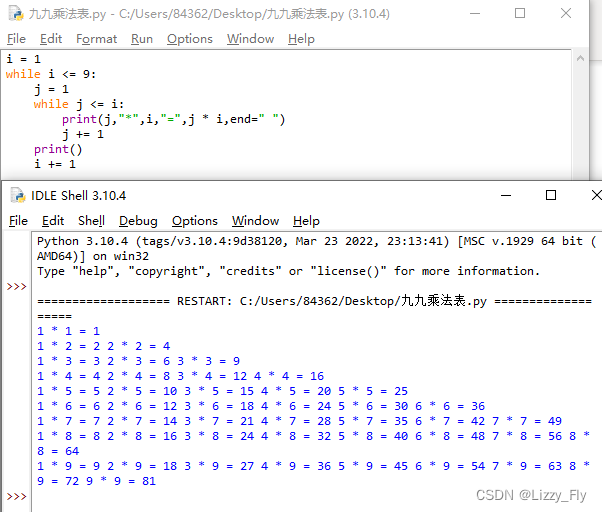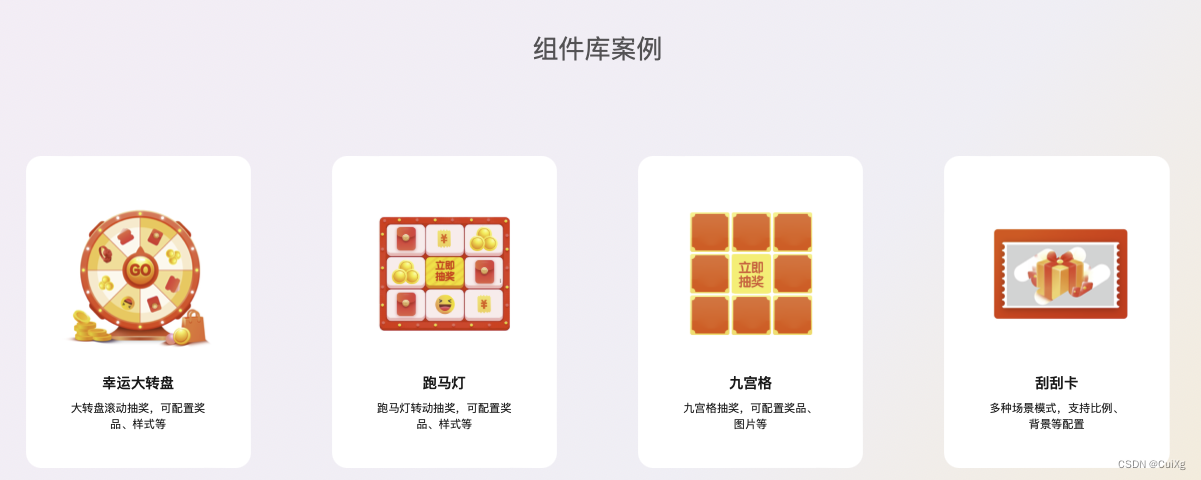目录
String类的常用方法
1.1 字符串构造
1.2 String对象的比较
1.3 字符串查找
1.4 转换
1.5 字符串替换
1.6字符串拆分
1.7 字符串截取
1.8 其他操作方法
1.9 字符串的不可变性
1.10 字符串修改
String类的常用方法
1.1 字符串构造
String类常用的构造方法有很多,常用的就以下三种:
public static void main(String[] args) {
// 使用常量串构造
String s1 = "hello bit";
System.out.println(s1);
// 直接newString对象
String s2 = new String("hello bit");
System.out.println(s1);
// 使用字符数组进行构造
char[] array = {'h','e','l','l','o','b','i','t'};
String s3 = new String(array);
System.out.println(s1);
}
【注意】
1. String是引用类型,内部并不存储字符串本身,在String类的实现源码中,String类实例变量如下:

实际上String有着两个成员变量,一个是字符数组,另一个是整型变量:
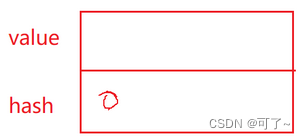
public static void main(String[] args) {
// s1和s2引用的是不同对象 s1和s3引用的是同一对象
String s1 = new String("hello");
String s2 = new String("world");
String s3 = s1;
System.out.println(s1.length()); // 获取字符串长度---输出5
System.out.println(s1.isEmpty()); // 如果字符串长度为0,返回true,否则返回false
}
如下图:

2. 在Java中“”引起来的也是String类型对象。
// 打印"hello"字符串(String对象)的长度
System.out.println("hello".length());
1.2 String对象的比较
字符串的比较是常见操作之一,比如:字符串排序。Java中总共提供了4中方式:
1. ==比较是否引用同一个对象
注意:对于内置类型,==比较的是变量中的值;对于引用类型==比较的是引用中的地址。
public static void main(String[] args) {
int a = 10;
int b = 20;
int c = 10;
// 对于基本类型变量,==比较两个变量中存储的值是否相同
System.out.println(a == b); // false
System.out.println(a == c); // true
// 对于引用类型变量,==比较两个引用变量引用的是否为同一个对象
String s1 = new String("hello");
String s2 = new String("hello");
String s3 = new String("world");
String s4 = s1;
System.out.println(s1 == s2); // false
System.out.println(s2 == s3); // false
System.out.println(s1 == s4); // true
}
2. boolean equals(Object anObject) 方法:按照字典序比较
字典序:字符大小的顺序
String类重写了父类Object中equals方法,Object中equals默认按照==比较,String重写equals方法后,按照如下规则进行比较,比如: s1.equals(s2)。
public boolean equals(Object anObject) {
// 1. 先检测this 和 anObject 是否为同一个对象比较,如果是返回true
if (this == anObject) {
return true;
}
// 2. 检测anObject是否为String类型的对象,如果是继续比较,否则返回false
if (anObject instanceof String) {
// 将anObject向下转型为String类型对象
String anotherString = (String)anObject;
int n = value.length;
// 3. this和anObject两个字符串的长度是否相同,是继续比较,否则返回false
if (n == anotherString.value.length) {
char v1[] = value;
char v2[] = anotherString.value;
int i = 0;
// 4. 按照字典序,从前往后逐个字符进行比较
while (n-- != 0) {
if (v1[i] != v2[i])
return false;
i++;
}
return true;
}
}
return false;}
public static void main(String[] args) {
String s1 = new String("hello");
String s2 = new String("hello");
String s3 = new String("Hello");
// s1、s2、s3引用的是三个不同对象,因此==比较结果全部为false
System.out.println(s1 == s2); // false
System.out.println(s1 == s3); // false
// equals比较:String对象中的逐个字符
// 虽然s1与s2引用的不是同一个对象,但是两个对象中放置的内容相同,因此输出true
// s1与s3引用的不是同一个对象,而且两个对象中内容也不同,因此输出false
System.out.println(s1.equals(s2)); // true
System.out.println(s1.equals(s3)); // false
}
3. int compareTo(String s) 方法: 按照字典序进行比较
与equals不同的是,equals返回的是boolean类型,而compareTo返回的是int类型。具体比较方式:
1. 先按照字典次序大小比较,如果出现不等的字符,直接返回这两个字符的大小差值。
2. 如果前k个字符相等(k为两个字符当中的长度最小值),返回值两个字符串长度差值。
public static void main(String[] args) {
String s1 = new String("abc");
String s2 = new String("ac");
String s3 = new String("abc");
String s4 = new String("abcdef");
System.out.println(s1.compareTo(s2)); // 不同输出字符差值-1
System.out.println(s1.compareTo(s3)); // 相同输出 0
System.out.println(s1.compareTo(s4)); // 前k个字符完全相同,输出长度差值 -3
}
4. int compareToIgnoreCase(String str) 方法:与compareTo方式相同,但是忽略大小写比较
public static void main(String[] args) {
String s1 = new String("abc");
String s2 = new String("ac");
String s3 = new String("ABc");
String s4 = new String("abcdef");
System.out.println(s1.compareToIgnoreCase(s2)); // 不同输出字符差值-1
System.out.println(s1.compareToIgnoreCase(s3)); // 相同输出 0
System.out.println(s1.compareToIgnoreCase(s4)); // 前k个字符完全相同,输出长度差值 -3
}
1.3 字符串查找
字符串查找也是字符串中非常常见的操作,String类提供的常用查找的方法(都是关于charAt,indexOf和lastindexOf的,前面的是查找对应位置的字符,后面两个是查找对应字符的位置):
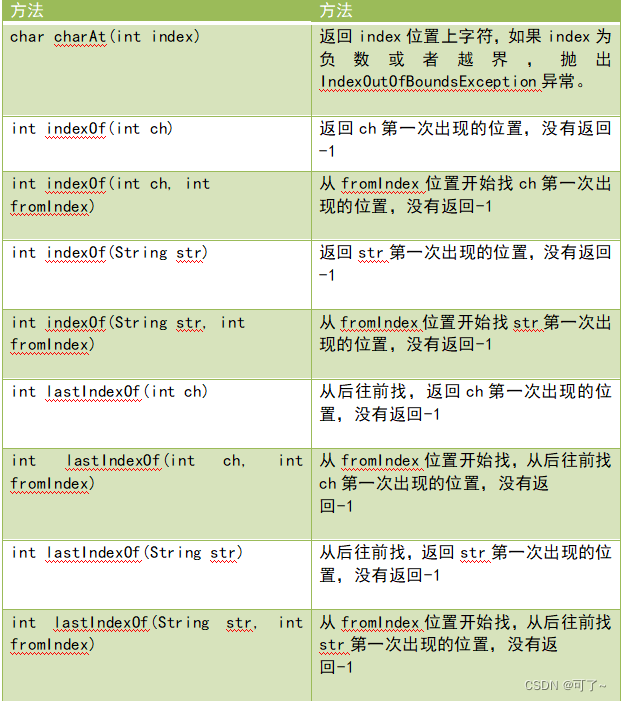
public static void main(String[] args) {
String s = "aaabbbcccaaabbbccc";
System.out.println(s.charAt(3)); // 'b'
System.out.println(s.indexOf('c')); // 6
System.out.println(s.indexOf('c', 10)); // 15
System.out.println(s.indexOf("bbb")); // 3
System.out.println(s.indexOf("bbb", 10)); // 12
System.out.println(s.lastIndexOf('c')); // 17
System.out.println(s.lastIndexOf('c', 10)); // 8
System.out.println(s.lastIndexOf("bbb")); // 12
System.out.println(s.lastIndexOf("bbb", 10)); // 3}
注意:上述方法都是实例方法(实例方法是为了对象而设计的,方法没有static,需要依赖对象进行调用)。
1.4 转换
1. 数值和字符串转化
public static void main(String[] args) {
// 数字转字符串
String s1 = String.valueOf(1234);
String s2 = String.valueOf(12.34);
String s3 = String.valueOf(true);
String s4 = String.valueOf(new Student("Hanmeimei", 18));
System.out.println(s1);
System.out.println(s2);System.out.println(s3);
System.out.println(s4);
System.out.println("=================================");输出:
1234
12.34
true
Test@1b6d3586=============================
// 字符串转数字
// 注意:Integer、Double等是Java中的包装类型,这个后面会讲到
int data1 = Integer.parseInt("1234");
double data2 = Double.parseDouble("12.34");
System.out.println(data1);
System.out.println(data2);
}
2.大小写转换
public static void main(String[] args) {
String s1 = "hello";
String s2 = "HELLO";
// 小写转大写
System.out.println(s1.toUpperCase());
// 大写转小写
System.out.println(s2.toLowerCase());
}
3. 字符串转数组
public static void main(String[] args) {
String s = "hello";
// 字符串转数组
char[] ch = s.toCharArray();
for (int i = 0; i < ch.length; i++) {
System.out.print(ch[i]);
}
System.out.println();
// 数组转字符串
String s2 = new String(ch);
System.out.println(s2);
}
4. 格式化
public static void main(String[] args) {
String s = String.format("%d-%d-%d", 2019, 9,14);
System.out.println(s);
}//输出 2019-9-14
1.5 字符串替换
使用一个指定的新的字符串替换掉已有的字符串数据,可用的方法如下:
方法 :
String replaceAll(String regex, String replacement)功能:替换所有的指定内容。
方法:
String replaceFirst(String regex, String replacement)
功能:替换首个内容。
代码示例: 字符串的替换处理。
String str = "helloworld" ;
System.out.println(str.replaceAll("l", "_"));
System.out.println(str.replaceFirst("l", "_"));
注意事项: 由于字符串是不可变对象, 替换不修改当前字符串, 而是产生一个新的字符串。
1.6字符串拆分
可以将一个完整的字符串按照指定的分隔符划分为若干个子字符串。
可用方法如下:
方法:
String[] split(String regex)功能:将字符串全部拆分
方法:
String[] split(String regex, int limit)
功能: 将字符串以指定的格式,拆分为limit组
代码示例: 实现字符串的拆分处理
String str = "hello world hello bit" ;
String[] result = str.split(" ") ; // 按照空格拆分
for(String s: result) {
System.out.println(s);
}输出结果:
hello
world
hello
bit
代码示例: 字符串的部分拆分
String str = "hello world hello bit" ;
String[] result = str.split(" ",2) ;
for(String s: result) {
System.out.println(s);
}输出结果:
hello
world hello hello bit
拆分是特别常用的操作. 一定要重点掌握. 另外有些特殊字符作为分割符可能无法正确切分, 需要加上转义。
代码示例: 拆分IP地址(加上转义):
String str = "192.168.1.1" ;
String[] result = str.split("\\.") ;
for(String s: result) {
System.out.println(s);
}输出:
192
168
1
1
注意事项:
1. 字符"|","*","+"都得加上转义字符,前面加上 "\\" 。
2. 而如果是 "\" ,那么就得写成 "\\\\" 。
3. 如果一个字符串中有多个分隔符,可以用"|"作为连字符。
代码示例: 多次拆分
String str = "name=zhangsan&age=18" ;
String[] result = str.split("&") ;
for (int i = 0; i < result.length; i++) {
String[] temp = result[i].split("=") ;
System.out.println(temp[0]+" = "+temp[1]);
}输出:
name = zhangsan
age = 18
这种代码在以后的开发之中会经常出现。
1.7 字符串截取
从一个完整的字符串之中截取出部分内容。可用方法如下:
方法:
String substring(int beginIndex)功能:从指定索引截取到结尾。
方法:String substring(int beginIndex, int endIndex)功能:截取部分内容。
代码示例: 观察字符串截取
String str = "helloworld" ;
System.out.println(str.substring(5));
System.out.println(str.substring(0, 5));
注意事项:
1. 索引从0开始。
2. 注意前闭后开区间的写法, substring(0, 5) 表示包含 0 号下标的字符, 不包含 5 号下标。
1.8 其他操作方法

代码示例: 观察trim()方法的使用:
String str = " hello world " ;
System.out.println("["+str+"]"); //[ hello world ]
System.out.println("["+str.trim()+"]"); //[hello world]
trim 会去掉字符串开头和结尾的空白字符(空格, 换行, 制表符等)。
代码示例: 大小写转换
String str = " hello%$$%@#$%world 哈哈哈 " ;
System.out.println(str.toUpperCase()); //HELLO%$$%@#$%WORLD哈哈哈
System.out.println(str.toLowerCase()); //hello%$$%@#$%world 哈哈哈
这两个函数只转换字母。
1.9 字符串的不可变性
String是一种不可变对象. 字符串中的内容是不可改变。字符串不可被修改,是因为:
1. String类在设计时就是不可改变的,String类实现描述中已经说明了
以下来自JDK1.8中String类的部分实现:
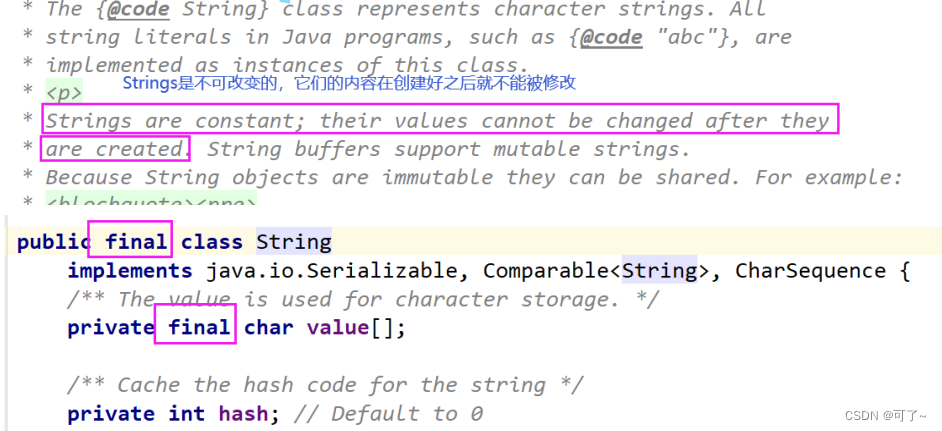
String类中的字符实际保存在内部维护的value字符数组中,该图还可以看出:
- String类被final修饰,表明该类不能被继承。
- value被final修饰,表明value自身的值不能改变,即不能引用其它字符数组,但是其引用空间中的内容可以修改。对于value来说,value是private的,而String类中没有setter方法,所以是value中的元素是不可以改变的。
2. 所有涉及到可能修改字符串内容的操作都是创建一个新对象,改变的是新对象。
【纠正】网上有些人说:字符串不可变是因为其内部保存字符的数组被final修饰了,因此不能改变。
这种说法是错误的,不是因为String类自身,或者其内部value被final修饰而不能被修改。
final修饰类表明该类不想被继承,final修饰引用类型表明该引用变量不能引用其他对象,但是其引用对象中的内容是可以修改的。
public static void main(String[] args) {
final int array[] = {1,2,3,4,5};
array[0] = 100;
System.out.println(Arrays.toString(array));
// array = new int[]{4,5,6}; // 编译报错:Error:(19, 9) java: 无法为最终变量array分配值
}
1.10 字符串修改
注意:尽量避免直接对String类型对象进行修改,因为String类是不能修改的,所有的修改都会创建新对象,效率非常低下。
public static void main(String[] args) {
String s = "hello";
s += " world";
System.out.println(s); // 输出:hello world
}
但是这种方式不推荐使用,因为其效率非常低,中间创建了好多临时对象。
因此:尽量避免对String的直接需要,如果要修改建议尽量使用StringBuffer或者StringBuilder。
对于StringBuffer 和 StringBuilder,可以看这篇博客。



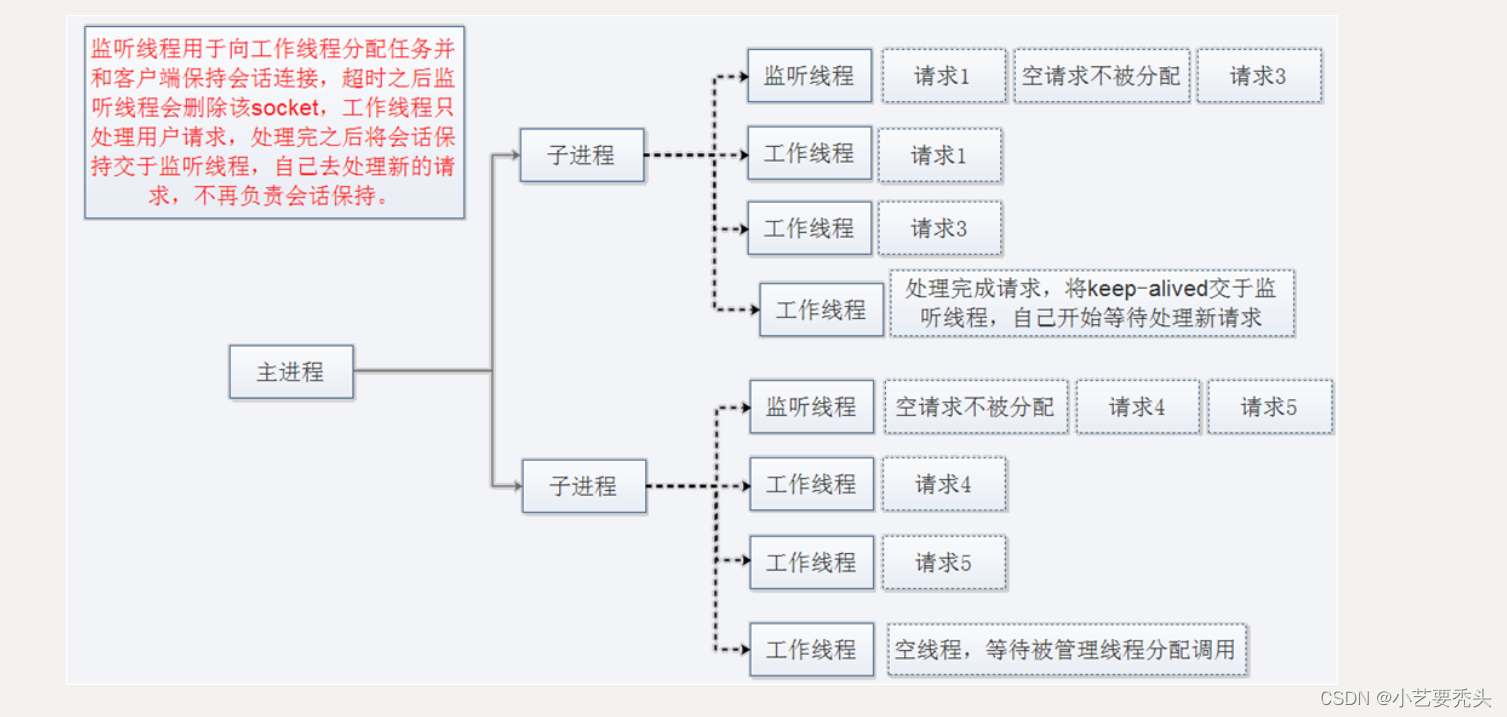


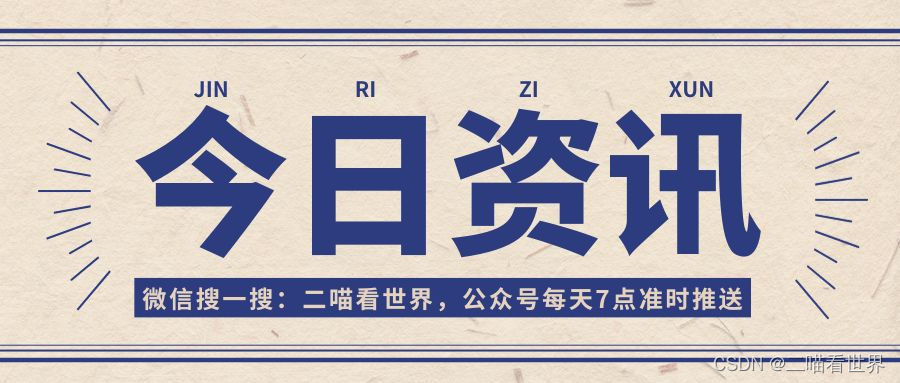

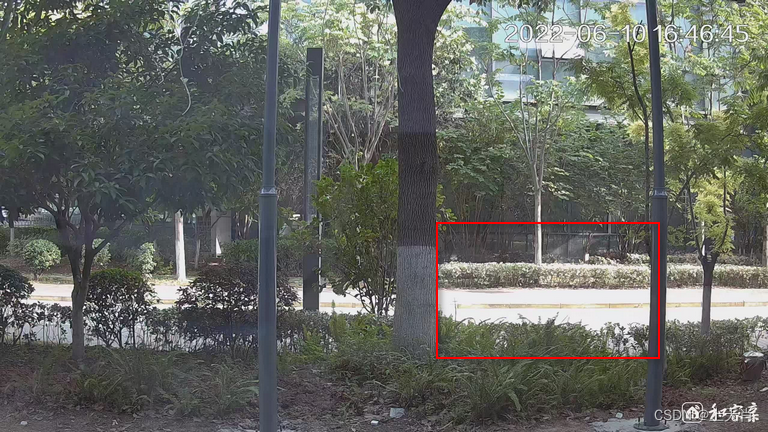


![[word] 如何将word文本转换成表格? #知识分享#学习方法#媒体](https://img-blog.csdnimg.cn/img_convert/15e34d6cccf36d654d05b70e2535a6a7.gif)




